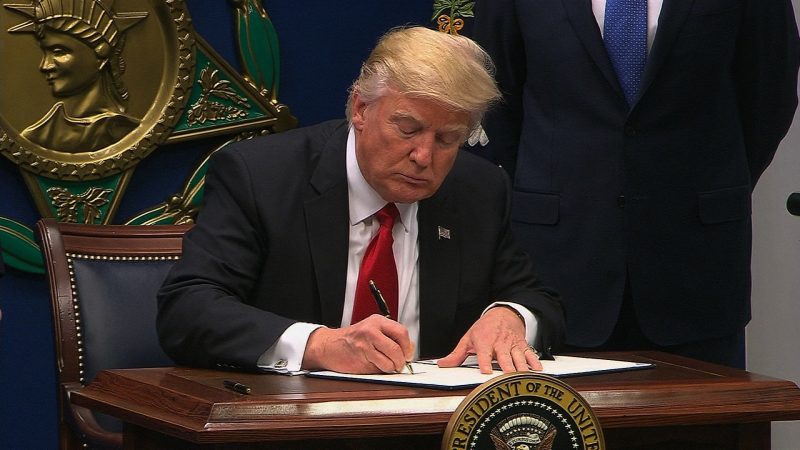What a difference five weeks makes.
The confusion and chaos that followed President Donald Trump’s January executive order limiting the flow of refugees into the United States was supplanted Monday by more deliberate planning.
Trump aides have claimed for weeks that there was nothing fundamentally wrong with the initial executive order. But, in private, Trump administration officials have admitted that there were issues with the way the first order was rushed out of the White House with little consultation from other agencies that would be tasked with implementing the order.
The rapid halting of Trump’s immigration order gave him his first exposure to the limits on his presidential power, a sharp awakening for a real estate mogul accustomed to the wide unilateral prerogative of a chief executive. The uncertainty over the order illustrated again the chaotic fallout of the new President’s intent in rapidly fulfilling his most controversial campaign promises.
But it certainly appears the White House learned several lessons from its first try.
This time, the order granted federal agencies 10 days to comply, top officials elicited feedback from agencies and lawmakers before implementation, and the order sought to provide key exemptions for certain immigrants.
“I think we lost the element of surprise back when we said we were issuing a second executive order,” White House spokesman Sean Spicer said, explaining the change in tactic. “We have telegraphed what we were doing for the last several weeks.”
The White House also held a number of meetings with the top officials at the Department of Homeland Security, the Justice Department and the State Department to smooth out mistakes made in the previous order and address some of the nagging concerns raised by experts within the Trump administration, multiple White House officials said.
Trump’s signing Monday was also dramatically more low-key than his earlier attempt, a sign he was keen to avoid press scrutiny this time around. While Trump signed the first executive order to pomp and circumstance in January, Monday’s signing was private, with only one still photograph being sent out by the White House.
And instead of Trump being the face of the order, a trio of his top Cabinet secretaries — Secretary of State Rex Tillerson, Secretary of Homeland Security John Kelly and Attorney General Jeff Sessions — were out in front of the cameras Monday.
‘Nothing wrong’
“There was nothing wrong with that first executive order as a legal matter,” a senior Department of Homeland Security official told reporters on Monday, hours before the second order was signed.
A senior official at the Justice Department also told reporters that the newest order will result in a “very orderly process,” a direct contrast with the mass protests, deportations and detainment that defined the weekend after Trump’s first order.
“You should not see any chaos, so to speak, or alleged chaos,” the official said.
White House officials were confident in saying that in part because of the way the administration tailored the plan, dropping key provisions from the first order.
Unlike the first order, legal permanent residents of the United States — along with valid visas holders — will not be affected by the new order, a dramatic change from the first attempt. Additionally, in an effort to comply with court orders against the first ban, religious minorities have no longer been given priority, and a blanket ban on Syrian refugees was also removed.
Iraq removed
Iraq was also removed from the initial list of seven — now six — countries directly impacted from the updated order. The removal comes after intensive lobbying from the Iraqi government at the highest levels, according to a senior US official.
That included a phone call between President Trump and Iraqi Prime Minister Haider al-Abadi on February 10 and an in-person conversation between Abadi and Vice President Mike Pence in Munich on February 18.
A senior Department of Homeland Security official said Monday that the decision to withdraw Iraq from the list comes as the country gave the United States assurances it will enhance its screening processes.
Trump also faced pressure to remove Iraq from the order from some American national security officials, who argued the restriction burdened a key anti-ISIS partner. Some of those voices were holdovers from the Obama administration.
Timing
Trump officials — and the President himself — had been hinting the new order was imminent for weeks. But despite arguing the importance of the ban, the White House itself decided to delay its signing in an attempt to take advantage of a positive news cycle, albeit one that was short-lived.
Speaking in mid-February at a high-profile national security conference in Germany, DHS secretary Kelly previewed a “tighter, more streamlined version of the first executive order.”
But after Trump’s well-received address to a joint session of Congress, White House aides postponed the order until later in the week in an attempt to extend the positive spotlight.
The end of last week, however, soon became consumed with stories about potential connections between members of Trump’s campaign and Russia. Trump himself left the White House Friday enraged at how his staff handled the Russia news — and without signing a new order.
On Saturday evening, Trump discussed the new order over dinner at his Florida mansion with Kelly, Sessions and White House policy director Stephen Miller — the original architect of the travel ban. It was there that Trump’s brain trust decided it was best to issue the new executive order while rescinding the older one.
